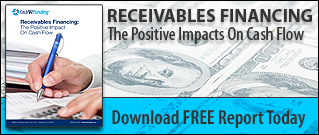Finding a factoring facility can be a daunting task. If you’ve never factored before, you’re going to hear terms and numbers and calculations that sound completely foreign. While a good factoring company should be able to explain everything in a way that makes sense, there’s one piece of the puzzle that you should have a very clear understanding of – the invoice factoring rates.
Even if you’re not a numbers person, you should take the time to really understand what the rates are and how they’ll be calculated. There should be no question on the cost of the service. The last thing you want is to receive funding from a factor and end up paying more that you were expecting.
.jpg?width=580&height=386&name=159429296_(1).jpg) How Invoice Factoring Rates Work
How Invoice Factoring Rates Work
The fee structure of a typical factoring facility revolves around the invoice amount. You’ll usually pay a certain percentage of the dollar amount of the invoice that’s factored. The actual percentage will be based on how long it takes for the invoice to be paid. Your fee will be higher on an invoice that was paid in 90 days than it will be for one that is paid in 30 days.
How this fee structure actually breaks down will vary depending on the factoring company, but typically you’re given pricing “buckets” where the first 15 days are a certain rate, the next 15 days are a certain rate, etc.
For example:
- If the invoice is paid in 1-15 days, the fee is .75%.
- If the invoice is paid in 16-30 days, the fee is 1.25%
- If the invoice is paid in 31-60 days, the fee is 2.25%
- Etc.
The day ranges and percentages will probably be different, but that’s the idea of how the fees work.
How to Compare Rates between Factors
Once you understand the fee structure, you’ll want to make sure that the invoice factoring rates are competitive. The problem is it’s often difficult to make a direct comparison of the rates. The pricing “buckets” may be divided differently or there may be a flat fee for a certain period with a daily rate thereafter. In addition, different advance rates impact your fees as well.
Rather than getting caught up in the details of the pricing structures, run the calculations for yourself to see what you would have paid under each plan using your invoices that were paid in the last 30 days.
Putting rate plans side by side is often like comparing apples and oranges. Running the numbers of each plan using your own invoice history gives you solid numbers to make a decision with.
Other Fees to Watch Out For
If I haven’t confused you yet, let me add one more thing – “other” fees. I call them other fees because they can be just about anything under the sun. Some are simple pass-through fees like the cost of pulling a credit report. Some are more opaque with names like collateral management fee or unused line fee.
The specifics of the fees aren’t important in and of themselves. What’s important is that you fully understand if there are any fees that you’ll be paying in addition to the invoice factoring rates. Be especially weary if you get a low quote from a factor. Chances are their quoted rate is low because they have a long list of other fees buried in the fine print of the agreement.
Navigating the Treacherous Waters
How do you protect yourself from getting into a contract that’s loaded with surprise fees? How can you know up front exactly what you’ll be paying?
- Work with a reputable factor. Read reviews and get referrals from others in your industry. Make sure you’re comfortable with the company after talking to them.
- Read your agreement in full – every single word. Yes, they’re written by attorneys. Yes, they can be difficult to understand. You still need to understand what you’re signing. If you don’t understand something, a good factoring company will get on the phone with you and walk through the entire agreement in detail.
- Don’t be afraid to share a term sheet or factoring agreement with another factor for comparison. A good factoring company will walk through the agreement with you and provide a comparison so you can make an informed decision.
Hopefully, I haven’t scared you off. I don’t say all of this to incite fear, but to emphasize how important the issue is. We work with clients all of the time that receive low-ball quotes only to be burdened by fees in the fine-print that weren’t mentioned in the initial quote. When talking to factoring companies, be sure you understand their invoice factoring rates and any other fees that go along with it.







